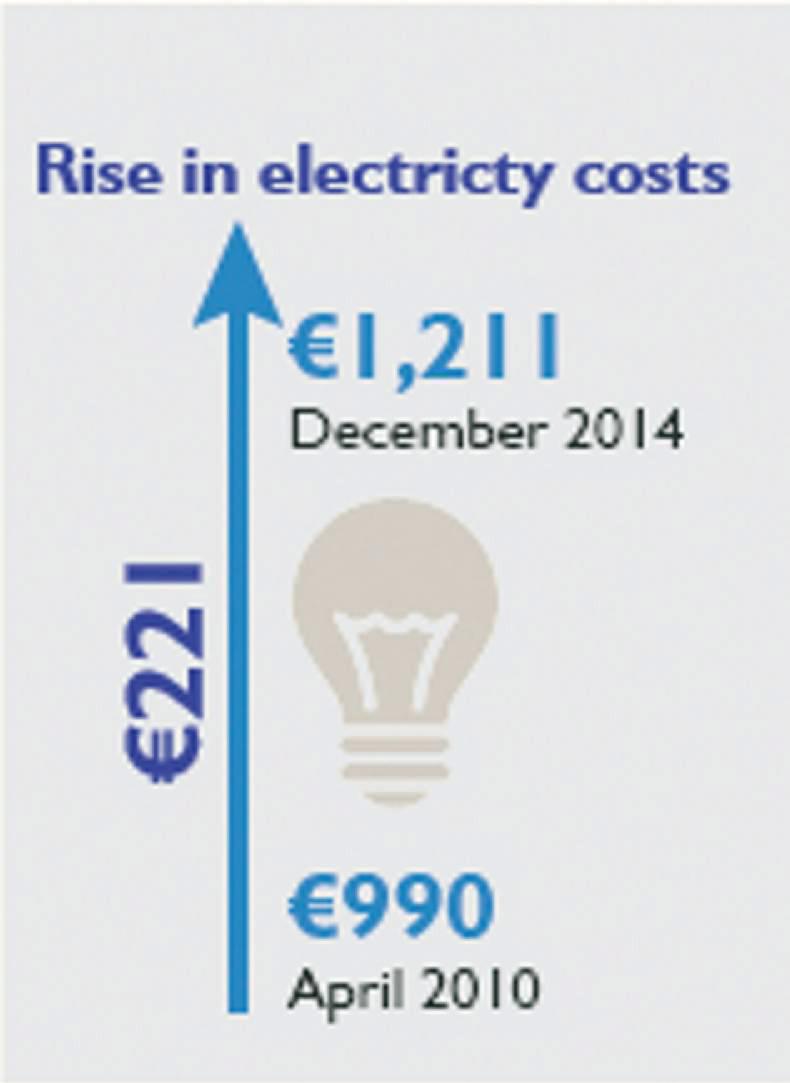How much of an increase are you seeing each month as the bills arrive through the letterbox? As part of our May consumer series, we’re looking at how costs have increased for Irish households in the last five years. Overall, the figures to run the typical Irish household have increased. Based on 2014 house prices, the average annual cost of owning and maintaining a home in Ireland is in the region of €15,400, according to the AA. This figure equates to 43% of the average current Irish annual wage in Ireland of €35,765.
However, given that the latest figures from Teagasc report that income for farming families is in the region of €25,437, this is significantly more.
In an effort to drill down into those figures even more, Irish Country Living is focusing on the price increases that are typical to many Irish households, specifically those bills that arrive through your door, such as electricity and broadband fees.
Electricity on the Up
Figures provided to Irish Country Living by bonkers.ie, show that the average household is now paying €220 more on electricity a year, compared with 2010, an increase of 22%, see table 1. Based on standard tariffs from Electric Ireland, the rates that the majority of households are signed up for, consumers were looking at annual bills of €990 for electricity in 2010, equating to €82.50 per month.
Many would have seen a big jump up to €1,236 by October 2014, an average of €103 a month. Although that figure dipped slightly in December, overall, we are paying close to €20 a month more on electricity in five years.
Combined figures
When combined with figures for piped gas with Bord Gáis, an average household is now paying over €450 more than it was in 2010.
Simon Moynihan of bonkers.ie says consumers have been quite conservative with their usage.
“Even though households have actually reduced their electricity and gas consumption over the last few years, it hasn’t compensated for the price increases.”
In an effort to reduce bills as much as possible, it is essential to check the rates you’re paying and to identify where savings can be made.
“The difference between paying standard rates, which 85% of Irish households pay, and signing up to discounted deals is €300 per year, or €25 per month,” says Simon.
So by switching you could potentially beat some of the price increases that we have seen.
Limited cover
When it comes to broadband in rural Ireland, its coverage that continues to be the main concern.
According to the 2014 EU Broadband study, 97% of the total population have access to broadband. However, this figure drops to 93% in rural areas. Access is just one side of the story though. Many rural households may be paying for the service but speeds continue to be an issue.
Currently, just 35% of the population has access to speeds of 100 Mbps. A further 15% of users have access to speeds of over 70 Mbps. However, that leaves the remaining 50% accessing much slower speeds in the range of 30 to 40 Mbps and unfortunately, many of these users are based in rural areas.
Broadband price falls
Despite issues surrounding speeds and coverage, prices are improving for some. Back in April 2010, if you wanted Eircom’s top 24MB broadband product households were paying €70 per month, according to bonkers.ie. The package provided would include off-peak calls, but you would be restricted to a usage allowance of 75GB a month. Now, however, that package costs €53, but it includes 100MB speeds with unlimited data, as well as your off peak calls.
Unfortunately, this good news story does not apply to many families in rural Ireland. The main products available to rural dwellers is 1MB and up to 8MB, which in reality means about 2MB or 3MB maximum – if you’re lucky enough to be near an exchange. Speaking to the IFA, packages such as those outlined above may have decreased for reasons such as competition with UPC, but as coverage remains limited, the benefits of this are not felt by many of our readers.
In fact, prices have stayed stagnant, with little improvement in service. If cable or phone line-based broadband is not an option in your area, then you may be looking at fixed wireless services. These services can cost as much as €80 per month.
The only difference that rural dwellers may have noticed is that companies like Ripplecom have a broader reach now than five years ago, potentially offering an alternative.
Too good to be true
The 3 network is also becoming more available, but remember if prices seem too good to be true, they may well be. Some broadband plans offered by 3 are as low as €7.99 per month. However, users must be aware that plans this cheap have a monthly data of 1GB and so are only suitable for very occasional users. If you go over that allowance, you could be faced with charges that are far in excess of that €7.99, as some Irish Country Living readers in the west found out.
Families could be better off paying more for additional data to avoid unplanned costs associated with their broadband bill. The 3 Pro plan, for example, costs €39.99, but has 60GB of data.
While broadband costs not only affect the outgoings of the farming family, it can also affect the income. Tim O’Leary, IFA countryside chair says: “Inadequate broadband service continues to undermine the enterprise potential and opportunities for rural Ireland. Government must now make the much needed investment to deliver a high speed, future-proofed solution to rural homes, farms and businesses and address the vast digital divide that exists in many parts of rural Ireland.”






 This is a subscriber-only article
This is a subscriber-only article







SHARING OPTIONS: